Cost of Capital: Definitions, Models, and Significance (HBBAE 2K19)
VerifiedAdded on 2021/11/23
|10
|4075
|66
Report
AI Summary
This report, submitted by Salwa Buriro, provides a comprehensive overview of the cost of capital, encompassing its definitions, classifications (explicit and implicit), and significance in financial management. It explores the sources of finance, including equity, preference shares, and debt, and explains how to measure the cost of each. The report delves into the cost of debentures, preference share capital, equity shares (using dividend/price and earnings/price ratio methods), and retained earnings. Furthermore, it introduces and explains the Gordon's Model, detailing its assumptions, core principles, and its relationship to dividend policy and firm valuation. The report also touches upon the Walter's Model, although its details are not provided in the provided text. The report emphasizes the importance of the cost of capital in capital budgeting, capital structure decisions, dividend policy, and evaluating financial performance. This report provides a valuable resource for students studying finance and financial management.
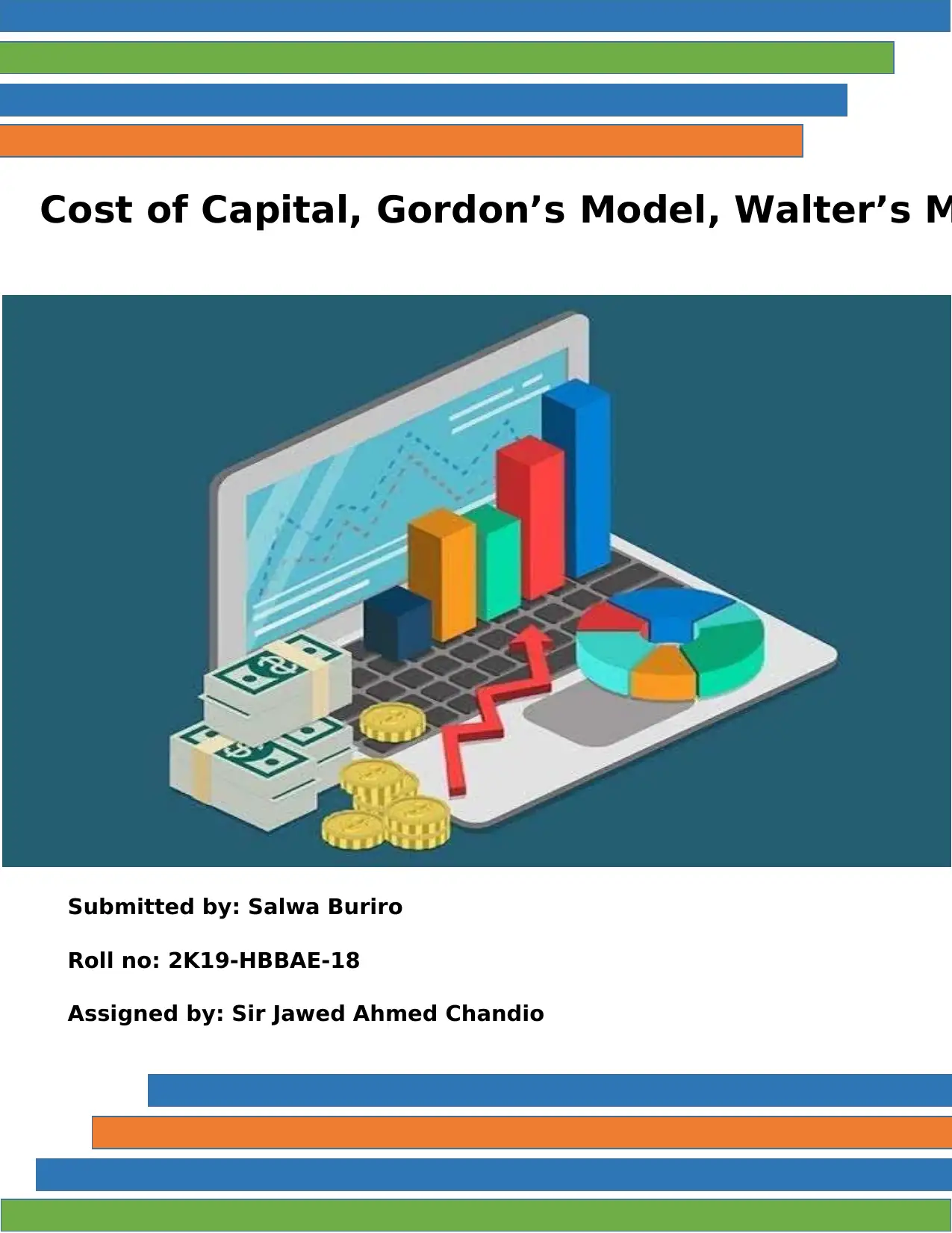
Cost of Capital, Gordon’s Model, Walter’s M
Submitted by: Salwa Buriro
Roll no: 2K19-HBBAE-18
Assigned by: Sir Jawed Ahmed Chandio
Submitted by: Salwa Buriro
Roll no: 2K19-HBBAE-18
Assigned by: Sir Jawed Ahmed Chandio
Paraphrase This Document
Need a fresh take? Get an instant paraphrase of this document with our AI Paraphraser
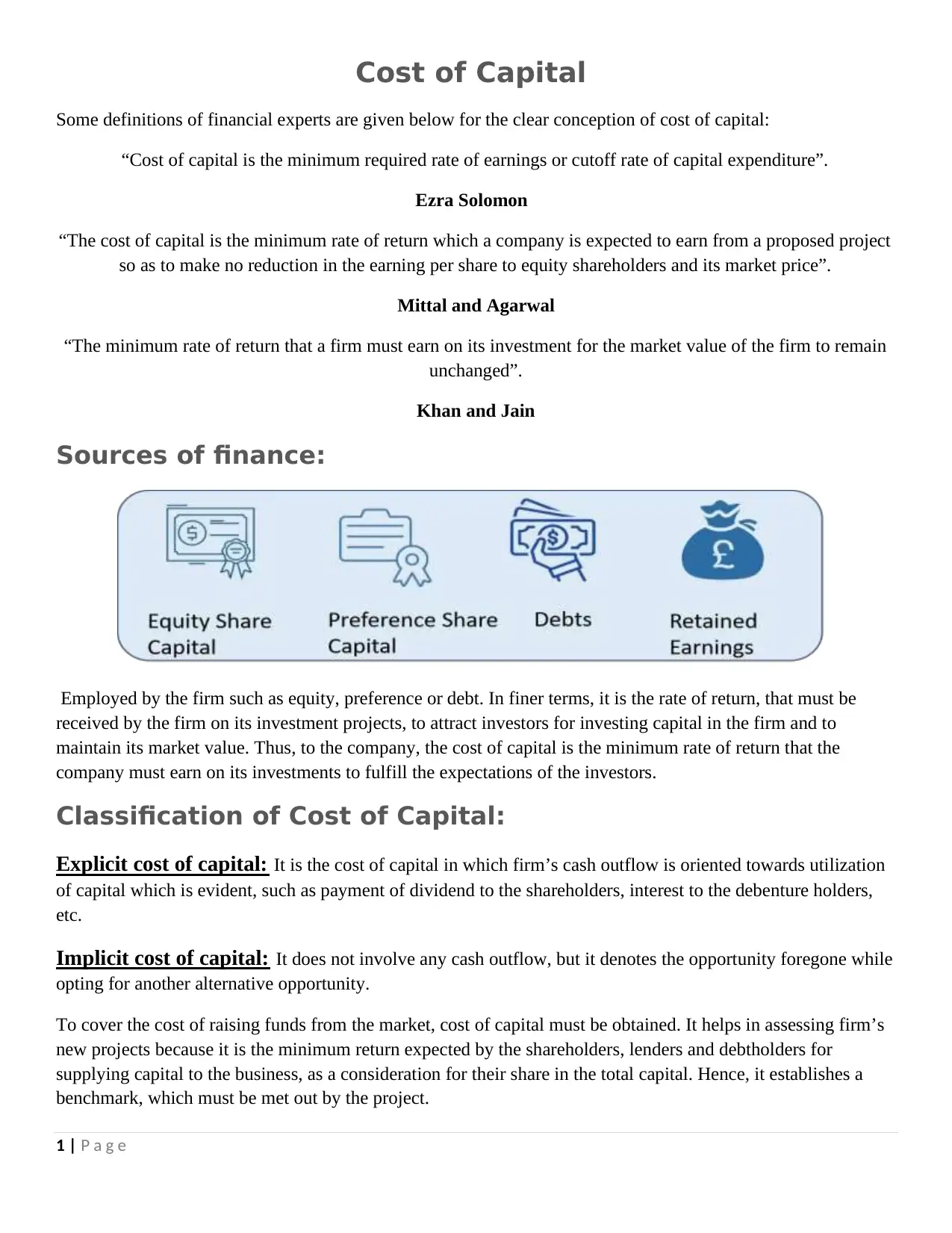
1 | P a g e
Cost of Capital
Some definitions of financial experts are given below for the clear conception of cost of capital:
“Cost of capital is the minimum required rate of earnings or cutoff rate of capital expenditure”.
Ezra Solomon
“The cost of capital is the minimum rate of return which a company is expected to earn from a proposed project
so as to make no reduction in the earning per share to equity shareholders and its market price”.
Mittal and Agarwal
“The minimum rate of return that a firm must earn on its investment for the market value of the firm to remain
unchanged”.
Khan and Jain
Sources of finance:
Employed by the firm such as equity, preference or debt. In finer terms, it is the rate of return, that must be
received by the firm on its investment projects, to attract investors for investing capital in the firm and to
maintain its market value. Thus, to the company, the cost of capital is the minimum rate of return that the
company must earn on its investments to fulfill the expectations of the investors.
Classification of Cost of Capital:
Explicit cost of capital: It is the cost of capital in which firm’s cash outflow is oriented towards utilization
of capital which is evident, such as payment of dividend to the shareholders, interest to the debenture holders,
etc.
Implicit cost of capital: It does not involve any cash outflow, but it denotes the opportunity foregone while
opting for another alternative opportunity.
To cover the cost of raising funds from the market, cost of capital must be obtained. It helps in assessing firm’s
new projects because it is the minimum return expected by the shareholders, lenders and debtholders for
supplying capital to the business, as a consideration for their share in the total capital. Hence, it establishes a
benchmark, which must be met out by the project.
Cost of Capital
Some definitions of financial experts are given below for the clear conception of cost of capital:
“Cost of capital is the minimum required rate of earnings or cutoff rate of capital expenditure”.
Ezra Solomon
“The cost of capital is the minimum rate of return which a company is expected to earn from a proposed project
so as to make no reduction in the earning per share to equity shareholders and its market price”.
Mittal and Agarwal
“The minimum rate of return that a firm must earn on its investment for the market value of the firm to remain
unchanged”.
Khan and Jain
Sources of finance:
Employed by the firm such as equity, preference or debt. In finer terms, it is the rate of return, that must be
received by the firm on its investment projects, to attract investors for investing capital in the firm and to
maintain its market value. Thus, to the company, the cost of capital is the minimum rate of return that the
company must earn on its investments to fulfill the expectations of the investors.
Classification of Cost of Capital:
Explicit cost of capital: It is the cost of capital in which firm’s cash outflow is oriented towards utilization
of capital which is evident, such as payment of dividend to the shareholders, interest to the debenture holders,
etc.
Implicit cost of capital: It does not involve any cash outflow, but it denotes the opportunity foregone while
opting for another alternative opportunity.
To cover the cost of raising funds from the market, cost of capital must be obtained. It helps in assessing firm’s
new projects because it is the minimum return expected by the shareholders, lenders and debtholders for
supplying capital to the business, as a consideration for their share in the total capital. Hence, it establishes a
benchmark, which must be met out by the project.
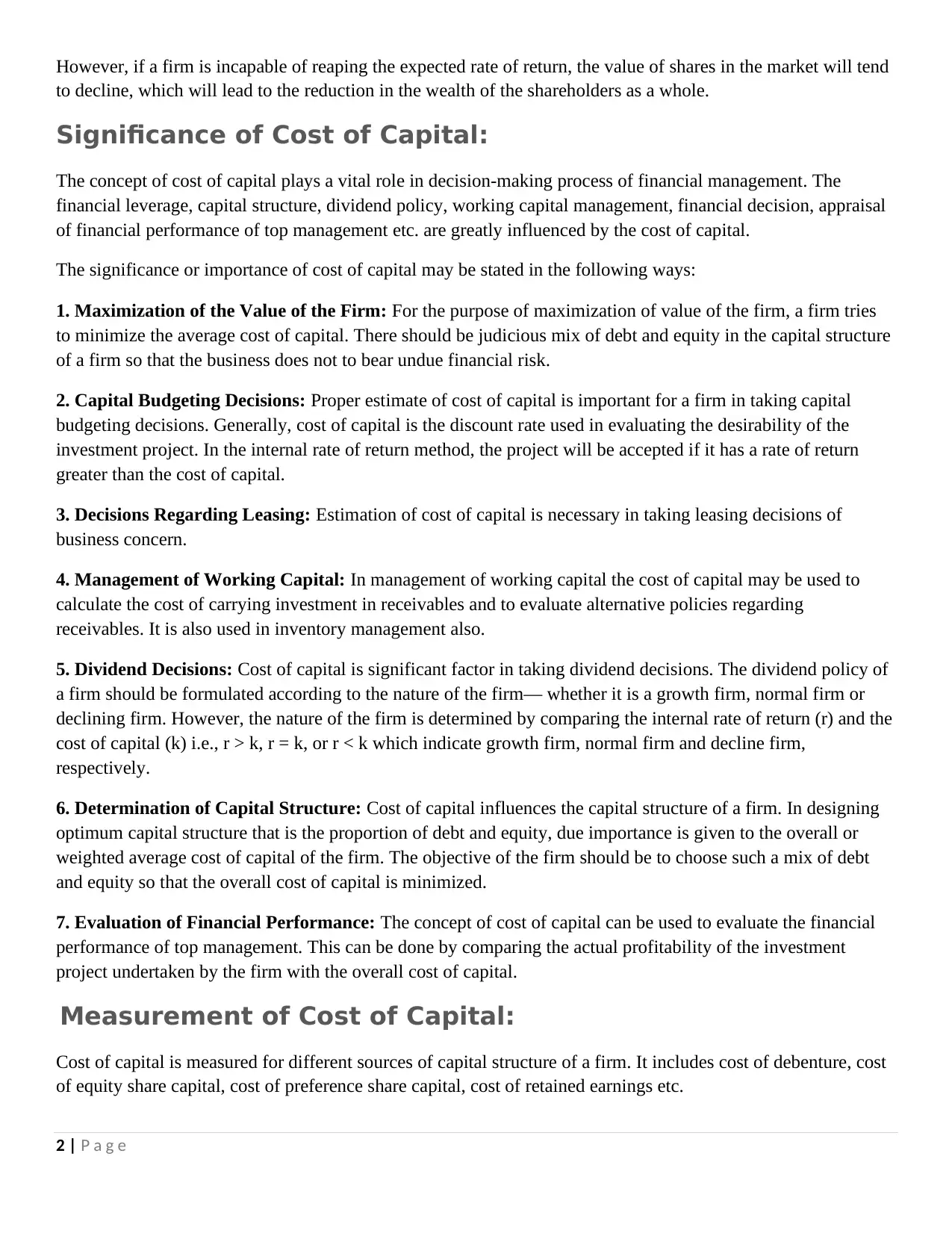
2 | P a g e
However, if a firm is incapable of reaping the expected rate of return, the value of shares in the market will tend
to decline, which will lead to the reduction in the wealth of the shareholders as a whole.
Significance of Cost of Capital:
The concept of cost of capital plays a vital role in decision-making process of financial management. The
financial leverage, capital structure, dividend policy, working capital management, financial decision, appraisal
of financial performance of top management etc. are greatly influenced by the cost of capital.
The significance or importance of cost of capital may be stated in the following ways:
1. Maximization of the Value of the Firm: For the purpose of maximization of value of the firm, a firm tries
to minimize the average cost of capital. There should be judicious mix of debt and equity in the capital structure
of a firm so that the business does not to bear undue financial risk.
2. Capital Budgeting Decisions: Proper estimate of cost of capital is important for a firm in taking capital
budgeting decisions. Generally, cost of capital is the discount rate used in evaluating the desirability of the
investment project. In the internal rate of return method, the project will be accepted if it has a rate of return
greater than the cost of capital.
3. Decisions Regarding Leasing: Estimation of cost of capital is necessary in taking leasing decisions of
business concern.
4. Management of Working Capital: In management of working capital the cost of capital may be used to
calculate the cost of carrying investment in receivables and to evaluate alternative policies regarding
receivables. It is also used in inventory management also.
5. Dividend Decisions: Cost of capital is significant factor in taking dividend decisions. The dividend policy of
a firm should be formulated according to the nature of the firm— whether it is a growth firm, normal firm or
declining firm. However, the nature of the firm is determined by comparing the internal rate of return (r) and the
cost of capital (k) i.e., r > k, r = k, or r < k which indicate growth firm, normal firm and decline firm,
respectively.
6. Determination of Capital Structure: Cost of capital influences the capital structure of a firm. In designing
optimum capital structure that is the proportion of debt and equity, due importance is given to the overall or
weighted average cost of capital of the firm. The objective of the firm should be to choose such a mix of debt
and equity so that the overall cost of capital is minimized.
7. Evaluation of Financial Performance: The concept of cost of capital can be used to evaluate the financial
performance of top management. This can be done by comparing the actual profitability of the investment
project undertaken by the firm with the overall cost of capital.
Measurement of Cost of Capital:
Cost of capital is measured for different sources of capital structure of a firm. It includes cost of debenture, cost
of equity share capital, cost of preference share capital, cost of retained earnings etc.
However, if a firm is incapable of reaping the expected rate of return, the value of shares in the market will tend
to decline, which will lead to the reduction in the wealth of the shareholders as a whole.
Significance of Cost of Capital:
The concept of cost of capital plays a vital role in decision-making process of financial management. The
financial leverage, capital structure, dividend policy, working capital management, financial decision, appraisal
of financial performance of top management etc. are greatly influenced by the cost of capital.
The significance or importance of cost of capital may be stated in the following ways:
1. Maximization of the Value of the Firm: For the purpose of maximization of value of the firm, a firm tries
to minimize the average cost of capital. There should be judicious mix of debt and equity in the capital structure
of a firm so that the business does not to bear undue financial risk.
2. Capital Budgeting Decisions: Proper estimate of cost of capital is important for a firm in taking capital
budgeting decisions. Generally, cost of capital is the discount rate used in evaluating the desirability of the
investment project. In the internal rate of return method, the project will be accepted if it has a rate of return
greater than the cost of capital.
3. Decisions Regarding Leasing: Estimation of cost of capital is necessary in taking leasing decisions of
business concern.
4. Management of Working Capital: In management of working capital the cost of capital may be used to
calculate the cost of carrying investment in receivables and to evaluate alternative policies regarding
receivables. It is also used in inventory management also.
5. Dividend Decisions: Cost of capital is significant factor in taking dividend decisions. The dividend policy of
a firm should be formulated according to the nature of the firm— whether it is a growth firm, normal firm or
declining firm. However, the nature of the firm is determined by comparing the internal rate of return (r) and the
cost of capital (k) i.e., r > k, r = k, or r < k which indicate growth firm, normal firm and decline firm,
respectively.
6. Determination of Capital Structure: Cost of capital influences the capital structure of a firm. In designing
optimum capital structure that is the proportion of debt and equity, due importance is given to the overall or
weighted average cost of capital of the firm. The objective of the firm should be to choose such a mix of debt
and equity so that the overall cost of capital is minimized.
7. Evaluation of Financial Performance: The concept of cost of capital can be used to evaluate the financial
performance of top management. This can be done by comparing the actual profitability of the investment
project undertaken by the firm with the overall cost of capital.
Measurement of Cost of Capital:
Cost of capital is measured for different sources of capital structure of a firm. It includes cost of debenture, cost
of equity share capital, cost of preference share capital, cost of retained earnings etc.
⊘ This is a preview!⊘
Do you want full access?
Subscribe today to unlock all pages.

Trusted by 1+ million students worldwide
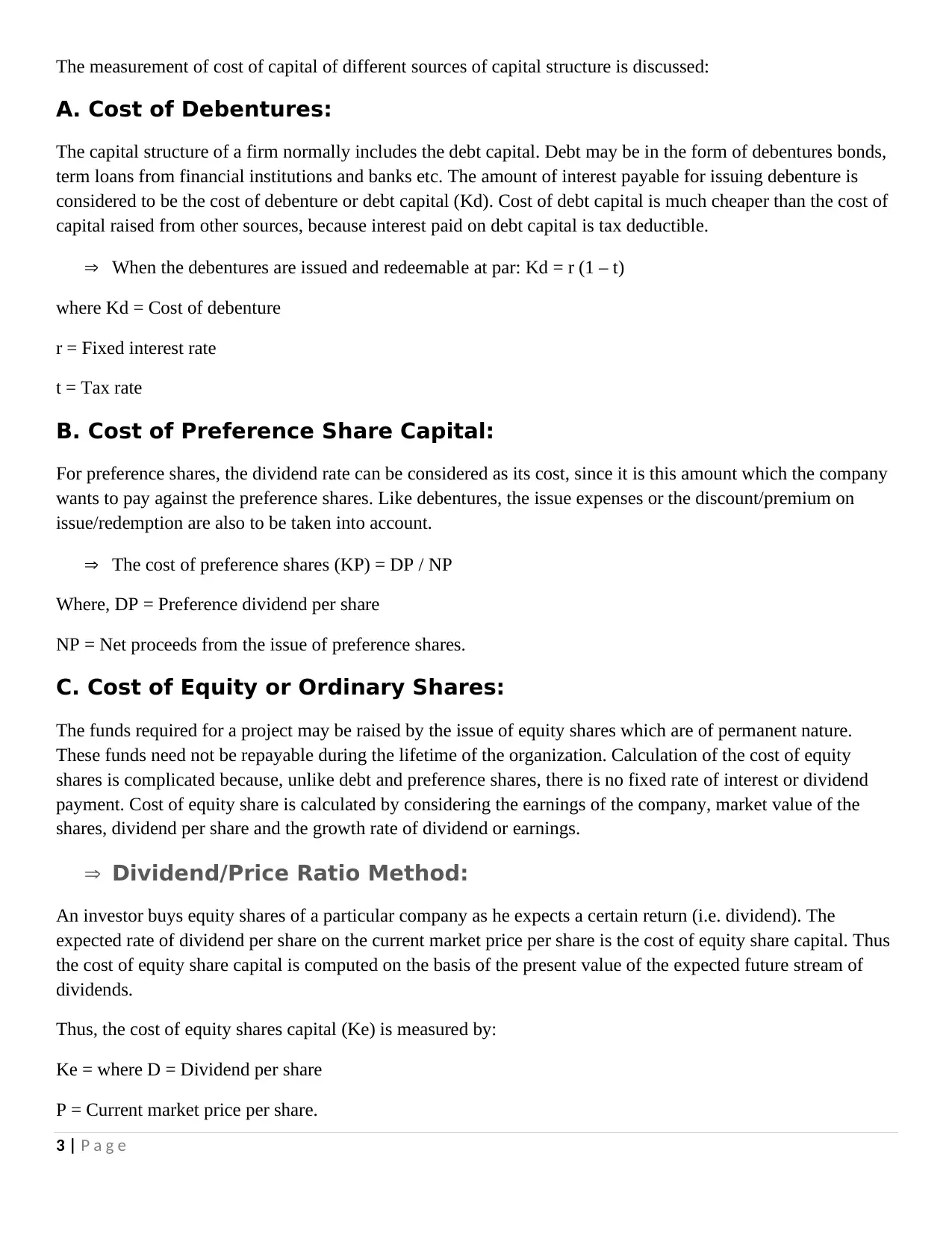
3 | P a g e
The measurement of cost of capital of different sources of capital structure is discussed:
A. Cost of Debentures:
The capital structure of a firm normally includes the debt capital. Debt may be in the form of debentures bonds,
term loans from financial institutions and banks etc. The amount of interest payable for issuing debenture is
considered to be the cost of debenture or debt capital (Kd). Cost of debt capital is much cheaper than the cost of
capital raised from other sources, because interest paid on debt capital is tax deductible.
When the debentures are issued and redeemable at par: Kd = r (1 – t)
where Kd = Cost of debenture
r = Fixed interest rate
t = Tax rate
B. Cost of Preference Share Capital:
For preference shares, the dividend rate can be considered as its cost, since it is this amount which the company
wants to pay against the preference shares. Like debentures, the issue expenses or the discount/premium on
issue/redemption are also to be taken into account.
The cost of preference shares (KP) = DP / NP
Where, DP = Preference dividend per share
NP = Net proceeds from the issue of preference shares.
C. Cost of Equity or Ordinary Shares:
The funds required for a project may be raised by the issue of equity shares which are of permanent nature.
These funds need not be repayable during the lifetime of the organization. Calculation of the cost of equity
shares is complicated because, unlike debt and preference shares, there is no fixed rate of interest or dividend
payment. Cost of equity share is calculated by considering the earnings of the company, market value of the
shares, dividend per share and the growth rate of dividend or earnings.
Dividend/Price Ratio Method:
An investor buys equity shares of a particular company as he expects a certain return (i.e. dividend). The
expected rate of dividend per share on the current market price per share is the cost of equity share capital. Thus
the cost of equity share capital is computed on the basis of the present value of the expected future stream of
dividends.
Thus, the cost of equity shares capital (Ke) is measured by:
Ke = where D = Dividend per share
P = Current market price per share.
The measurement of cost of capital of different sources of capital structure is discussed:
A. Cost of Debentures:
The capital structure of a firm normally includes the debt capital. Debt may be in the form of debentures bonds,
term loans from financial institutions and banks etc. The amount of interest payable for issuing debenture is
considered to be the cost of debenture or debt capital (Kd). Cost of debt capital is much cheaper than the cost of
capital raised from other sources, because interest paid on debt capital is tax deductible.
When the debentures are issued and redeemable at par: Kd = r (1 – t)
where Kd = Cost of debenture
r = Fixed interest rate
t = Tax rate
B. Cost of Preference Share Capital:
For preference shares, the dividend rate can be considered as its cost, since it is this amount which the company
wants to pay against the preference shares. Like debentures, the issue expenses or the discount/premium on
issue/redemption are also to be taken into account.
The cost of preference shares (KP) = DP / NP
Where, DP = Preference dividend per share
NP = Net proceeds from the issue of preference shares.
C. Cost of Equity or Ordinary Shares:
The funds required for a project may be raised by the issue of equity shares which are of permanent nature.
These funds need not be repayable during the lifetime of the organization. Calculation of the cost of equity
shares is complicated because, unlike debt and preference shares, there is no fixed rate of interest or dividend
payment. Cost of equity share is calculated by considering the earnings of the company, market value of the
shares, dividend per share and the growth rate of dividend or earnings.
Dividend/Price Ratio Method:
An investor buys equity shares of a particular company as he expects a certain return (i.e. dividend). The
expected rate of dividend per share on the current market price per share is the cost of equity share capital. Thus
the cost of equity share capital is computed on the basis of the present value of the expected future stream of
dividends.
Thus, the cost of equity shares capital (Ke) is measured by:
Ke = where D = Dividend per share
P = Current market price per share.
Paraphrase This Document
Need a fresh take? Get an instant paraphrase of this document with our AI Paraphraser
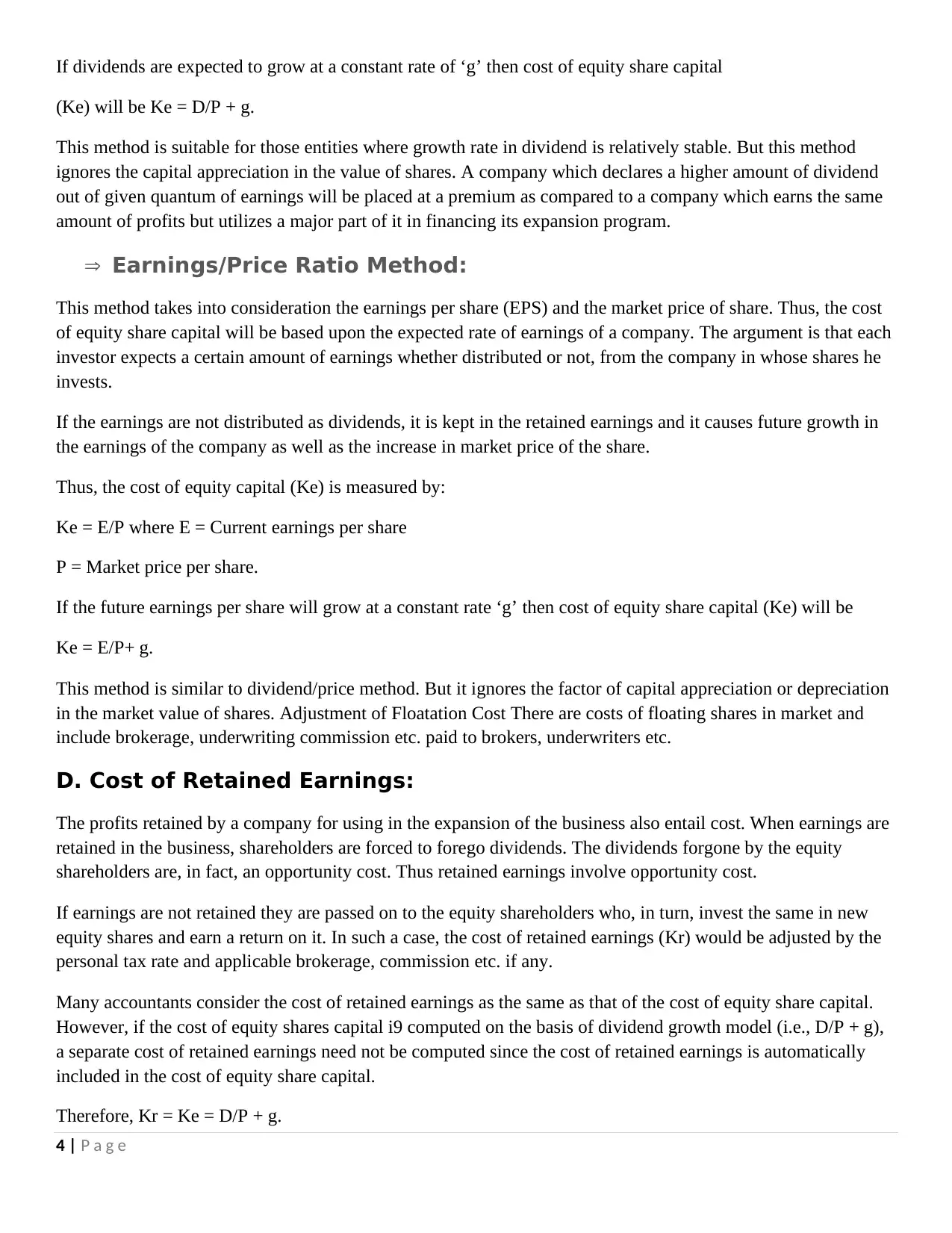
4 | P a g e
If dividends are expected to grow at a constant rate of ‘g’ then cost of equity share capital
(Ke) will be Ke = D/P + g.
This method is suitable for those entities where growth rate in dividend is relatively stable. But this method
ignores the capital appreciation in the value of shares. A company which declares a higher amount of dividend
out of given quantum of earnings will be placed at a premium as compared to a company which earns the same
amount of profits but utilizes a major part of it in financing its expansion program.
Earnings/Price Ratio Method:
This method takes into consideration the earnings per share (EPS) and the market price of share. Thus, the cost
of equity share capital will be based upon the expected rate of earnings of a company. The argument is that each
investor expects a certain amount of earnings whether distributed or not, from the company in whose shares he
invests.
If the earnings are not distributed as dividends, it is kept in the retained earnings and it causes future growth in
the earnings of the company as well as the increase in market price of the share.
Thus, the cost of equity capital (Ke) is measured by:
Ke = E/P where E = Current earnings per share
P = Market price per share.
If the future earnings per share will grow at a constant rate ‘g’ then cost of equity share capital (Ke) will be
Ke = E/P+ g.
This method is similar to dividend/price method. But it ignores the factor of capital appreciation or depreciation
in the market value of shares. Adjustment of Floatation Cost There are costs of floating shares in market and
include brokerage, underwriting commission etc. paid to brokers, underwriters etc.
D. Cost of Retained Earnings:
The profits retained by a company for using in the expansion of the business also entail cost. When earnings are
retained in the business, shareholders are forced to forego dividends. The dividends forgone by the equity
shareholders are, in fact, an opportunity cost. Thus retained earnings involve opportunity cost.
If earnings are not retained they are passed on to the equity shareholders who, in turn, invest the same in new
equity shares and earn a return on it. In such a case, the cost of retained earnings (Kr) would be adjusted by the
personal tax rate and applicable brokerage, commission etc. if any.
Many accountants consider the cost of retained earnings as the same as that of the cost of equity share capital.
However, if the cost of equity shares capital i9 computed on the basis of dividend growth model (i.e., D/P + g),
a separate cost of retained earnings need not be computed since the cost of retained earnings is automatically
included in the cost of equity share capital.
Therefore, Kr = Ke = D/P + g.
If dividends are expected to grow at a constant rate of ‘g’ then cost of equity share capital
(Ke) will be Ke = D/P + g.
This method is suitable for those entities where growth rate in dividend is relatively stable. But this method
ignores the capital appreciation in the value of shares. A company which declares a higher amount of dividend
out of given quantum of earnings will be placed at a premium as compared to a company which earns the same
amount of profits but utilizes a major part of it in financing its expansion program.
Earnings/Price Ratio Method:
This method takes into consideration the earnings per share (EPS) and the market price of share. Thus, the cost
of equity share capital will be based upon the expected rate of earnings of a company. The argument is that each
investor expects a certain amount of earnings whether distributed or not, from the company in whose shares he
invests.
If the earnings are not distributed as dividends, it is kept in the retained earnings and it causes future growth in
the earnings of the company as well as the increase in market price of the share.
Thus, the cost of equity capital (Ke) is measured by:
Ke = E/P where E = Current earnings per share
P = Market price per share.
If the future earnings per share will grow at a constant rate ‘g’ then cost of equity share capital (Ke) will be
Ke = E/P+ g.
This method is similar to dividend/price method. But it ignores the factor of capital appreciation or depreciation
in the market value of shares. Adjustment of Floatation Cost There are costs of floating shares in market and
include brokerage, underwriting commission etc. paid to brokers, underwriters etc.
D. Cost of Retained Earnings:
The profits retained by a company for using in the expansion of the business also entail cost. When earnings are
retained in the business, shareholders are forced to forego dividends. The dividends forgone by the equity
shareholders are, in fact, an opportunity cost. Thus retained earnings involve opportunity cost.
If earnings are not retained they are passed on to the equity shareholders who, in turn, invest the same in new
equity shares and earn a return on it. In such a case, the cost of retained earnings (Kr) would be adjusted by the
personal tax rate and applicable brokerage, commission etc. if any.
Many accountants consider the cost of retained earnings as the same as that of the cost of equity share capital.
However, if the cost of equity shares capital i9 computed on the basis of dividend growth model (i.e., D/P + g),
a separate cost of retained earnings need not be computed since the cost of retained earnings is automatically
included in the cost of equity share capital.
Therefore, Kr = Ke = D/P + g.
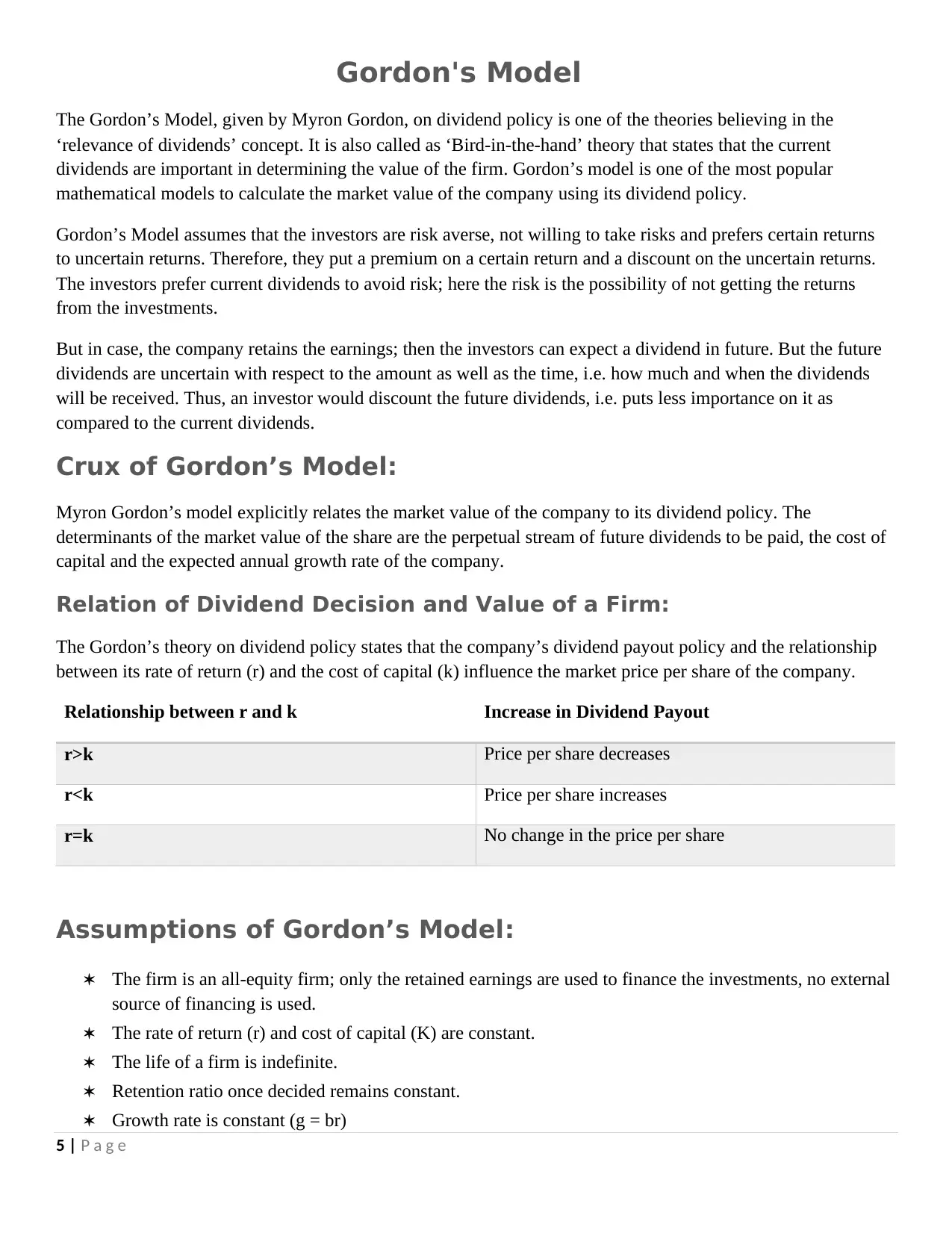
5 | P a g e
Gordon's Model
The Gordon’s Model, given by Myron Gordon, on dividend policy is one of the theories believing in the
‘relevance of dividends’ concept. It is also called as ‘Bird-in-the-hand’ theory that states that the current
dividends are important in determining the value of the firm. Gordon’s model is one of the most popular
mathematical models to calculate the market value of the company using its dividend policy.
Gordon’s Model assumes that the investors are risk averse, not willing to take risks and prefers certain returns
to uncertain returns. Therefore, they put a premium on a certain return and a discount on the uncertain returns.
The investors prefer current dividends to avoid risk; here the risk is the possibility of not getting the returns
from the investments.
But in case, the company retains the earnings; then the investors can expect a dividend in future. But the future
dividends are uncertain with respect to the amount as well as the time, i.e. how much and when the dividends
will be received. Thus, an investor would discount the future dividends, i.e. puts less importance on it as
compared to the current dividends.
Crux of Gordon’s Model:
Myron Gordon’s model explicitly relates the market value of the company to its dividend policy. The
determinants of the market value of the share are the perpetual stream of future dividends to be paid, the cost of
capital and the expected annual growth rate of the company.
Relation of Dividend Decision and Value of a Firm:
The Gordon’s theory on dividend policy states that the company’s dividend payout policy and the relationship
between its rate of return (r) and the cost of capital (k) influence the market price per share of the company.
Relationship between r and k Increase in Dividend Payout
r>k Price per share decreases
r<k Price per share increases
r=k No change in the price per share
Assumptions of Gordon’s Model:
The firm is an all-equity firm; only the retained earnings are used to finance the investments, no external
source of financing is used.
The rate of return (r) and cost of capital (K) are constant.
The life of a firm is indefinite.
Retention ratio once decided remains constant.
Growth rate is constant (g = br)
Gordon's Model
The Gordon’s Model, given by Myron Gordon, on dividend policy is one of the theories believing in the
‘relevance of dividends’ concept. It is also called as ‘Bird-in-the-hand’ theory that states that the current
dividends are important in determining the value of the firm. Gordon’s model is one of the most popular
mathematical models to calculate the market value of the company using its dividend policy.
Gordon’s Model assumes that the investors are risk averse, not willing to take risks and prefers certain returns
to uncertain returns. Therefore, they put a premium on a certain return and a discount on the uncertain returns.
The investors prefer current dividends to avoid risk; here the risk is the possibility of not getting the returns
from the investments.
But in case, the company retains the earnings; then the investors can expect a dividend in future. But the future
dividends are uncertain with respect to the amount as well as the time, i.e. how much and when the dividends
will be received. Thus, an investor would discount the future dividends, i.e. puts less importance on it as
compared to the current dividends.
Crux of Gordon’s Model:
Myron Gordon’s model explicitly relates the market value of the company to its dividend policy. The
determinants of the market value of the share are the perpetual stream of future dividends to be paid, the cost of
capital and the expected annual growth rate of the company.
Relation of Dividend Decision and Value of a Firm:
The Gordon’s theory on dividend policy states that the company’s dividend payout policy and the relationship
between its rate of return (r) and the cost of capital (k) influence the market price per share of the company.
Relationship between r and k Increase in Dividend Payout
r>k Price per share decreases
r<k Price per share increases
r=k No change in the price per share
Assumptions of Gordon’s Model:
The firm is an all-equity firm; only the retained earnings are used to finance the investments, no external
source of financing is used.
The rate of return (r) and cost of capital (K) are constant.
The life of a firm is indefinite.
Retention ratio once decided remains constant.
Growth rate is constant (g = br)
⊘ This is a preview!⊘
Do you want full access?
Subscribe today to unlock all pages.

Trusted by 1+ million students worldwide
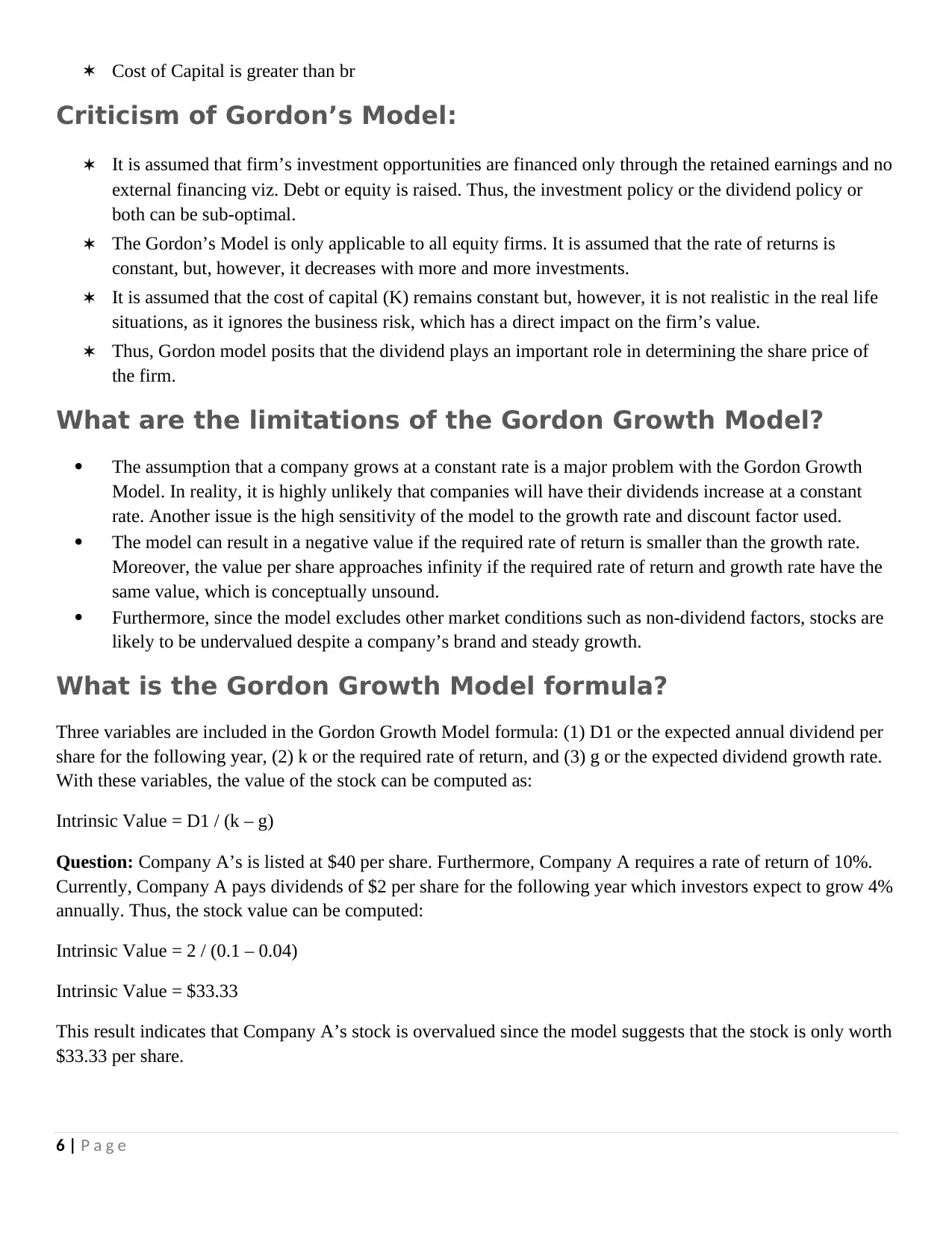
6 | P a g e
Cost of Capital is greater than br
Criticism of Gordon’s Model:
It is assumed that firm’s investment opportunities are financed only through the retained earnings and no
external financing viz. Debt or equity is raised. Thus, the investment policy or the dividend policy or
both can be sub-optimal.
The Gordon’s Model is only applicable to all equity firms. It is assumed that the rate of returns is
constant, but, however, it decreases with more and more investments.
It is assumed that the cost of capital (K) remains constant but, however, it is not realistic in the real life
situations, as it ignores the business risk, which has a direct impact on the firm’s value.
Thus, Gordon model posits that the dividend plays an important role in determining the share price of
the firm.
What are the limitations of the Gordon Growth Model?
The assumption that a company grows at a constant rate is a major problem with the Gordon Growth
Model. In reality, it is highly unlikely that companies will have their dividends increase at a constant
rate. Another issue is the high sensitivity of the model to the growth rate and discount factor used.
The model can result in a negative value if the required rate of return is smaller than the growth rate.
Moreover, the value per share approaches infinity if the required rate of return and growth rate have the
same value, which is conceptually unsound.
Furthermore, since the model excludes other market conditions such as non-dividend factors, stocks are
likely to be undervalued despite a company’s brand and steady growth.
What is the Gordon Growth Model formula?
Three variables are included in the Gordon Growth Model formula: (1) D1 or the expected annual dividend per
share for the following year, (2) k or the required rate of return, and (3) g or the expected dividend growth rate.
With these variables, the value of the stock can be computed as:
Intrinsic Value = D1 / (k – g)
Question: Company A’s is listed at $40 per share. Furthermore, Company A requires a rate of return of 10%.
Currently, Company A pays dividends of $2 per share for the following year which investors expect to grow 4%
annually. Thus, the stock value can be computed:
Intrinsic Value = 2 / (0.1 – 0.04)
Intrinsic Value = $33.33
This result indicates that Company A’s stock is overvalued since the model suggests that the stock is only worth
$33.33 per share.
Cost of Capital is greater than br
Criticism of Gordon’s Model:
It is assumed that firm’s investment opportunities are financed only through the retained earnings and no
external financing viz. Debt or equity is raised. Thus, the investment policy or the dividend policy or
both can be sub-optimal.
The Gordon’s Model is only applicable to all equity firms. It is assumed that the rate of returns is
constant, but, however, it decreases with more and more investments.
It is assumed that the cost of capital (K) remains constant but, however, it is not realistic in the real life
situations, as it ignores the business risk, which has a direct impact on the firm’s value.
Thus, Gordon model posits that the dividend plays an important role in determining the share price of
the firm.
What are the limitations of the Gordon Growth Model?
The assumption that a company grows at a constant rate is a major problem with the Gordon Growth
Model. In reality, it is highly unlikely that companies will have their dividends increase at a constant
rate. Another issue is the high sensitivity of the model to the growth rate and discount factor used.
The model can result in a negative value if the required rate of return is smaller than the growth rate.
Moreover, the value per share approaches infinity if the required rate of return and growth rate have the
same value, which is conceptually unsound.
Furthermore, since the model excludes other market conditions such as non-dividend factors, stocks are
likely to be undervalued despite a company’s brand and steady growth.
What is the Gordon Growth Model formula?
Three variables are included in the Gordon Growth Model formula: (1) D1 or the expected annual dividend per
share for the following year, (2) k or the required rate of return, and (3) g or the expected dividend growth rate.
With these variables, the value of the stock can be computed as:
Intrinsic Value = D1 / (k – g)
Question: Company A’s is listed at $40 per share. Furthermore, Company A requires a rate of return of 10%.
Currently, Company A pays dividends of $2 per share for the following year which investors expect to grow 4%
annually. Thus, the stock value can be computed:
Intrinsic Value = 2 / (0.1 – 0.04)
Intrinsic Value = $33.33
This result indicates that Company A’s stock is overvalued since the model suggests that the stock is only worth
$33.33 per share.
Paraphrase This Document
Need a fresh take? Get an instant paraphrase of this document with our AI Paraphraser
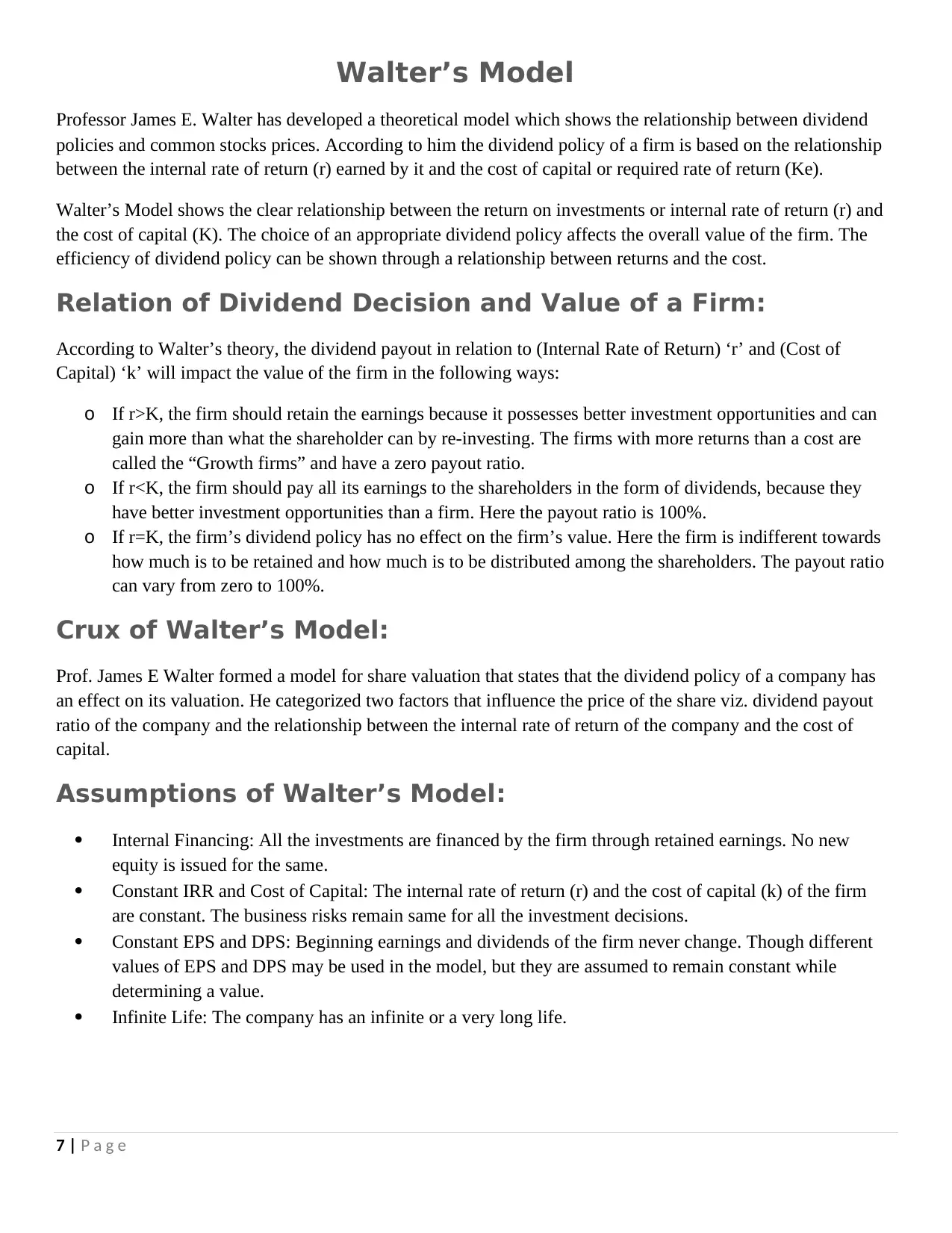
7 | P a g e
Walter’s Model
Professor James E. Walter has developed a theoretical model which shows the relationship between dividend
policies and common stocks prices. According to him the dividend policy of a firm is based on the relationship
between the internal rate of return (r) earned by it and the cost of capital or required rate of return (Ke).
Walter’s Model shows the clear relationship between the return on investments or internal rate of return (r) and
the cost of capital (K). The choice of an appropriate dividend policy affects the overall value of the firm. The
efficiency of dividend policy can be shown through a relationship between returns and the cost.
Relation of Dividend Decision and Value of a Firm:
According to Walter’s theory, the dividend payout in relation to (Internal Rate of Return) ‘r’ and (Cost of
Capital) ‘k’ will impact the value of the firm in the following ways:
o If r>K, the firm should retain the earnings because it possesses better investment opportunities and can
gain more than what the shareholder can by re-investing. The firms with more returns than a cost are
called the “Growth firms” and have a zero payout ratio.
o If r<K, the firm should pay all its earnings to the shareholders in the form of dividends, because they
have better investment opportunities than a firm. Here the payout ratio is 100%.
o If r=K, the firm’s dividend policy has no effect on the firm’s value. Here the firm is indifferent towards
how much is to be retained and how much is to be distributed among the shareholders. The payout ratio
can vary from zero to 100%.
Crux of Walter’s Model:
Prof. James E Walter formed a model for share valuation that states that the dividend policy of a company has
an effect on its valuation. He categorized two factors that influence the price of the share viz. dividend payout
ratio of the company and the relationship between the internal rate of return of the company and the cost of
capital.
Assumptions of Walter’s Model:
Internal Financing: All the investments are financed by the firm through retained earnings. No new
equity is issued for the same.
Constant IRR and Cost of Capital: The internal rate of return (r) and the cost of capital (k) of the firm
are constant. The business risks remain same for all the investment decisions.
Constant EPS and DPS: Beginning earnings and dividends of the firm never change. Though different
values of EPS and DPS may be used in the model, but they are assumed to remain constant while
determining a value.
Infinite Life: The company has an infinite or a very long life.
Walter’s Model
Professor James E. Walter has developed a theoretical model which shows the relationship between dividend
policies and common stocks prices. According to him the dividend policy of a firm is based on the relationship
between the internal rate of return (r) earned by it and the cost of capital or required rate of return (Ke).
Walter’s Model shows the clear relationship between the return on investments or internal rate of return (r) and
the cost of capital (K). The choice of an appropriate dividend policy affects the overall value of the firm. The
efficiency of dividend policy can be shown through a relationship between returns and the cost.
Relation of Dividend Decision and Value of a Firm:
According to Walter’s theory, the dividend payout in relation to (Internal Rate of Return) ‘r’ and (Cost of
Capital) ‘k’ will impact the value of the firm in the following ways:
o If r>K, the firm should retain the earnings because it possesses better investment opportunities and can
gain more than what the shareholder can by re-investing. The firms with more returns than a cost are
called the “Growth firms” and have a zero payout ratio.
o If r<K, the firm should pay all its earnings to the shareholders in the form of dividends, because they
have better investment opportunities than a firm. Here the payout ratio is 100%.
o If r=K, the firm’s dividend policy has no effect on the firm’s value. Here the firm is indifferent towards
how much is to be retained and how much is to be distributed among the shareholders. The payout ratio
can vary from zero to 100%.
Crux of Walter’s Model:
Prof. James E Walter formed a model for share valuation that states that the dividend policy of a company has
an effect on its valuation. He categorized two factors that influence the price of the share viz. dividend payout
ratio of the company and the relationship between the internal rate of return of the company and the cost of
capital.
Assumptions of Walter’s Model:
Internal Financing: All the investments are financed by the firm through retained earnings. No new
equity is issued for the same.
Constant IRR and Cost of Capital: The internal rate of return (r) and the cost of capital (k) of the firm
are constant. The business risks remain same for all the investment decisions.
Constant EPS and DPS: Beginning earnings and dividends of the firm never change. Though different
values of EPS and DPS may be used in the model, but they are assumed to remain constant while
determining a value.
Infinite Life: The company has an infinite or a very long life.
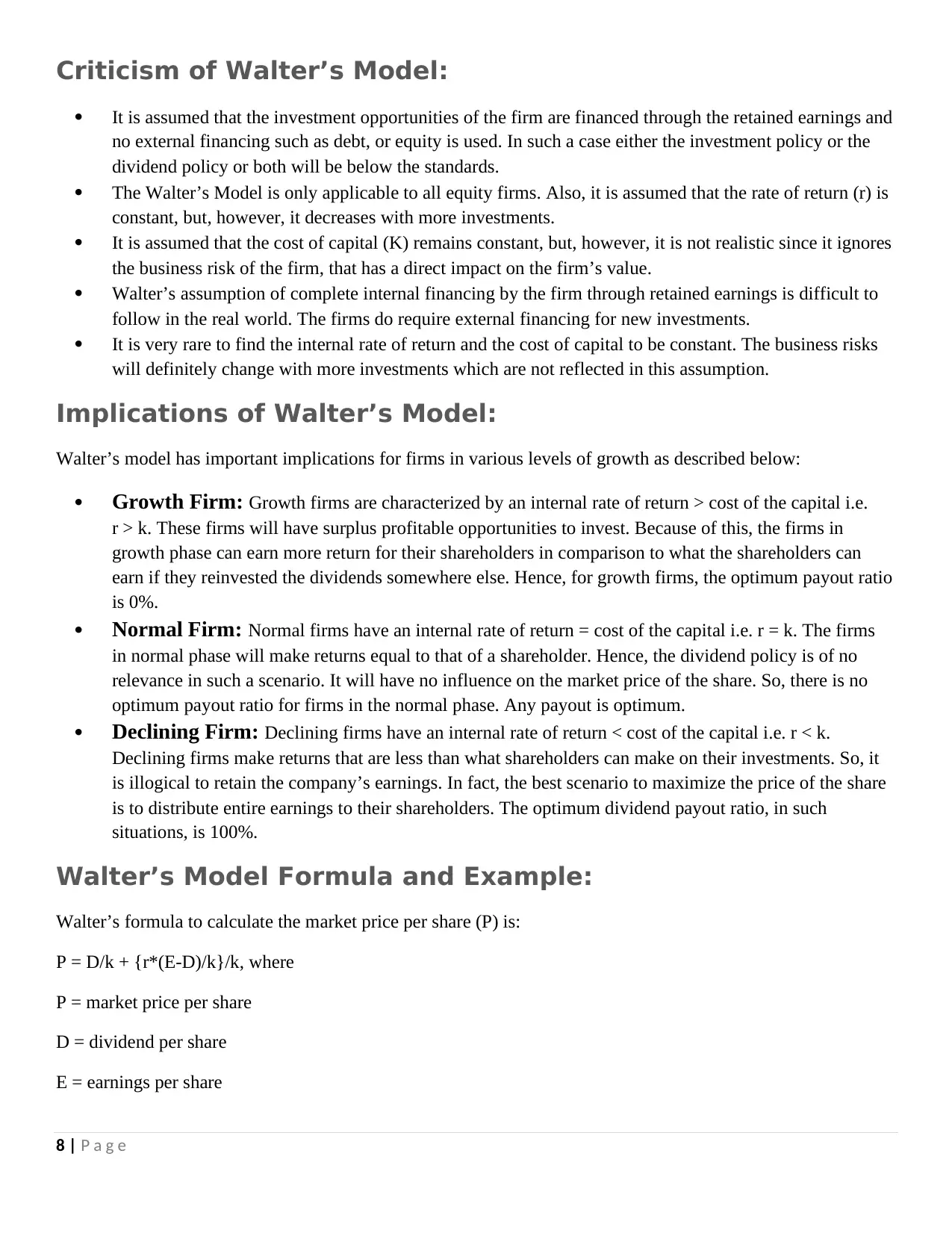
8 | P a g e
Criticism of Walter’s Model:
It is assumed that the investment opportunities of the firm are financed through the retained earnings and
no external financing such as debt, or equity is used. In such a case either the investment policy or the
dividend policy or both will be below the standards.
The Walter’s Model is only applicable to all equity firms. Also, it is assumed that the rate of return (r) is
constant, but, however, it decreases with more investments.
It is assumed that the cost of capital (K) remains constant, but, however, it is not realistic since it ignores
the business risk of the firm, that has a direct impact on the firm’s value.
Walter’s assumption of complete internal financing by the firm through retained earnings is difficult to
follow in the real world. The firms do require external financing for new investments.
It is very rare to find the internal rate of return and the cost of capital to be constant. The business risks
will definitely change with more investments which are not reflected in this assumption.
Implications of Walter’s Model:
Walter’s model has important implications for firms in various levels of growth as described below:
Growth Firm: Growth firms are characterized by an internal rate of return > cost of the capital i.e.
r > k. These firms will have surplus profitable opportunities to invest. Because of this, the firms in
growth phase can earn more return for their shareholders in comparison to what the shareholders can
earn if they reinvested the dividends somewhere else. Hence, for growth firms, the optimum payout ratio
is 0%.
Normal Firm: Normal firms have an internal rate of return = cost of the capital i.e. r = k. The firms
in normal phase will make returns equal to that of a shareholder. Hence, the dividend policy is of no
relevance in such a scenario. It will have no influence on the market price of the share. So, there is no
optimum payout ratio for firms in the normal phase. Any payout is optimum.
Declining Firm: Declining firms have an internal rate of return < cost of the capital i.e. r < k.
Declining firms make returns that are less than what shareholders can make on their investments. So, it
is illogical to retain the company’s earnings. In fact, the best scenario to maximize the price of the share
is to distribute entire earnings to their shareholders. The optimum dividend payout ratio, in such
situations, is 100%.
Walter’s Model Formula and Example:
Walter’s formula to calculate the market price per share (P) is:
P = D/k + {r*(E-D)/k}/k, where
P = market price per share
D = dividend per share
E = earnings per share
Criticism of Walter’s Model:
It is assumed that the investment opportunities of the firm are financed through the retained earnings and
no external financing such as debt, or equity is used. In such a case either the investment policy or the
dividend policy or both will be below the standards.
The Walter’s Model is only applicable to all equity firms. Also, it is assumed that the rate of return (r) is
constant, but, however, it decreases with more investments.
It is assumed that the cost of capital (K) remains constant, but, however, it is not realistic since it ignores
the business risk of the firm, that has a direct impact on the firm’s value.
Walter’s assumption of complete internal financing by the firm through retained earnings is difficult to
follow in the real world. The firms do require external financing for new investments.
It is very rare to find the internal rate of return and the cost of capital to be constant. The business risks
will definitely change with more investments which are not reflected in this assumption.
Implications of Walter’s Model:
Walter’s model has important implications for firms in various levels of growth as described below:
Growth Firm: Growth firms are characterized by an internal rate of return > cost of the capital i.e.
r > k. These firms will have surplus profitable opportunities to invest. Because of this, the firms in
growth phase can earn more return for their shareholders in comparison to what the shareholders can
earn if they reinvested the dividends somewhere else. Hence, for growth firms, the optimum payout ratio
is 0%.
Normal Firm: Normal firms have an internal rate of return = cost of the capital i.e. r = k. The firms
in normal phase will make returns equal to that of a shareholder. Hence, the dividend policy is of no
relevance in such a scenario. It will have no influence on the market price of the share. So, there is no
optimum payout ratio for firms in the normal phase. Any payout is optimum.
Declining Firm: Declining firms have an internal rate of return < cost of the capital i.e. r < k.
Declining firms make returns that are less than what shareholders can make on their investments. So, it
is illogical to retain the company’s earnings. In fact, the best scenario to maximize the price of the share
is to distribute entire earnings to their shareholders. The optimum dividend payout ratio, in such
situations, is 100%.
Walter’s Model Formula and Example:
Walter’s formula to calculate the market price per share (P) is:
P = D/k + {r*(E-D)/k}/k, where
P = market price per share
D = dividend per share
E = earnings per share
⊘ This is a preview!⊘
Do you want full access?
Subscribe today to unlock all pages.

Trusted by 1+ million students worldwide
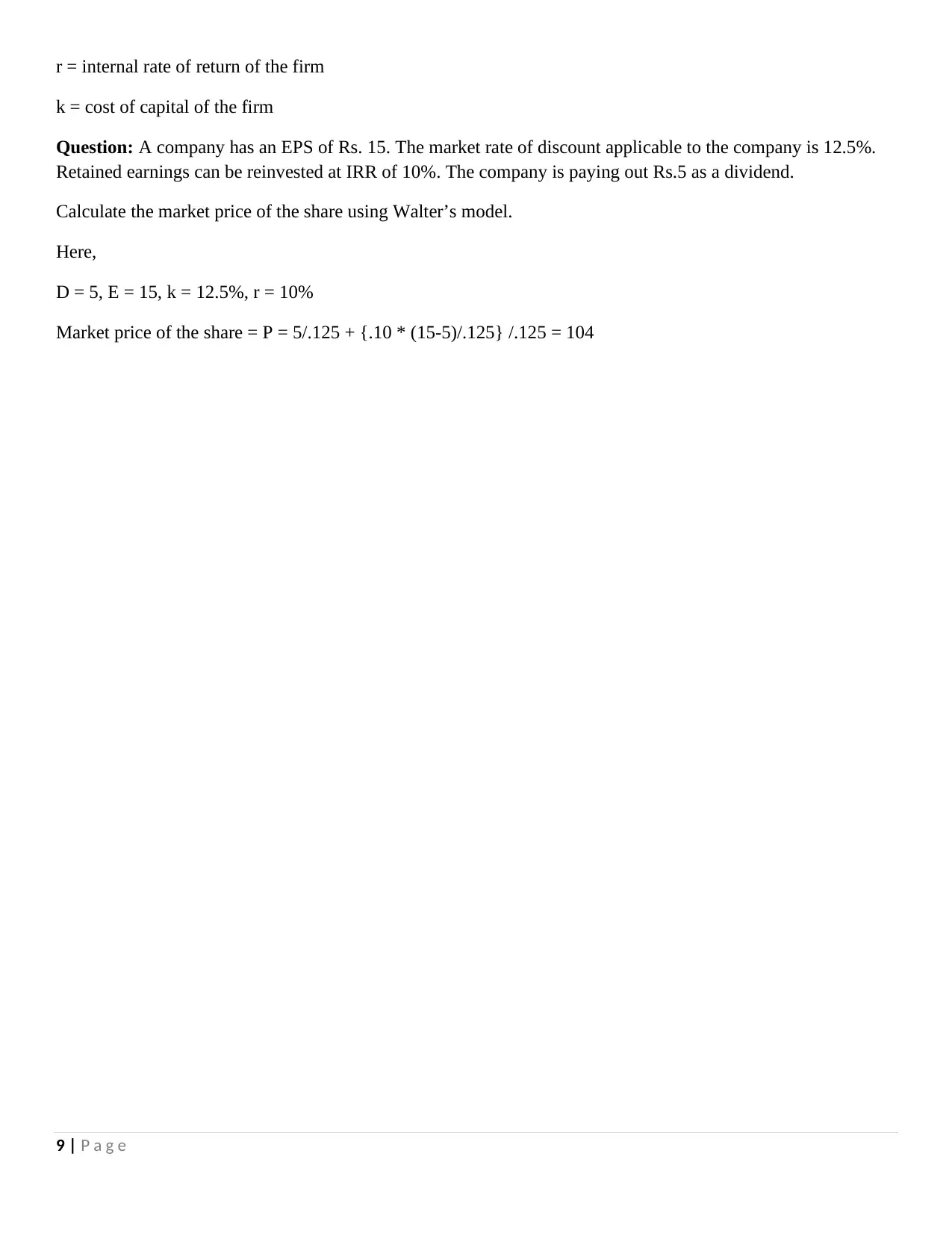
9 | P a g e
r = internal rate of return of the firm
k = cost of capital of the firm
Question: A company has an EPS of Rs. 15. The market rate of discount applicable to the company is 12.5%.
Retained earnings can be reinvested at IRR of 10%. The company is paying out Rs.5 as a dividend.
Calculate the market price of the share using Walter’s model.
Here,
D = 5, E = 15, k = 12.5%, r = 10%
Market price of the share = P = 5/.125 + {.10 * (15-5)/.125} /.125 = 104
r = internal rate of return of the firm
k = cost of capital of the firm
Question: A company has an EPS of Rs. 15. The market rate of discount applicable to the company is 12.5%.
Retained earnings can be reinvested at IRR of 10%. The company is paying out Rs.5 as a dividend.
Calculate the market price of the share using Walter’s model.
Here,
D = 5, E = 15, k = 12.5%, r = 10%
Market price of the share = P = 5/.125 + {.10 * (15-5)/.125} /.125 = 104
1 out of 10
Related Documents
Your All-in-One AI-Powered Toolkit for Academic Success.
+13062052269
info@desklib.com
Available 24*7 on WhatsApp / Email
![[object Object]](/_next/static/media/star-bottom.7253800d.svg)
Unlock your academic potential
Copyright © 2020–2025 A2Z Services. All Rights Reserved. Developed and managed by ZUCOL.




